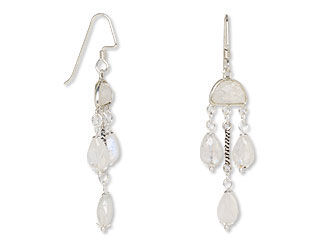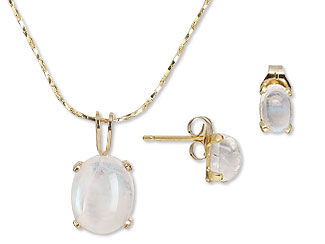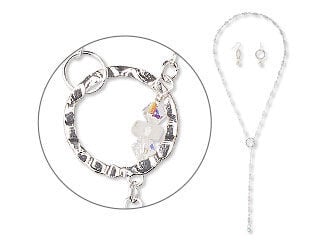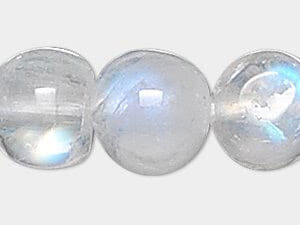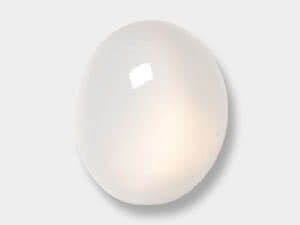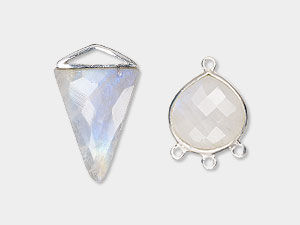Moonstone, Rainbow Meaning and Properties
Rainbow Moonstone History
Moonstone has translucent white color with a white sheen similar to "moonshine" that rolls or flows over the stone when rotated, hence the name "moonstone." The sheen is caused by light diffraction within layers of feldspar. Generally a creamy translucent white stone, rainbow moonstone features occasional iridescent or multicolored (especially blue) flashes with transparency that ranges from opaque to semitranslucent. Rainbow moonstone is best seen in natural light for play of color. Moonstone has been used in jewelry going back to ancient civilizations. The Romans believed moonstone was born from solidified rays of the moon. The Greeks and the Romans associated moonstone with their lunar gods. During the Art Nouveau period in the early 20th century, moonstone became popular with artists and goldsmiths for creating jewelry.
Unearth the beauty of rainbow moonstone and learn about its history, geological properties, proper care and design uses. Watch this video and learn how to best showcase its natural light for a striking play of color in your jewelry.

Rainbow Moonstone Metaphysical Properties
Moonstone is often called the visionary's stone. It helps us see things more clearly. Rainbow moonstone is thought to bring balance, harmony and hope while enhancing creativity, compassion, endurance and inner confidence. Rainbow moonstone is believed to help strengthen intuition and psychic perception, especially offering us visions of things that aren't immediately obvious. Because it helps us avoid tunnel vision, we are able to see other possibilities. It's like a flash of inspiration that comes when we are open and quiet. When we wear rainbow moonstone, life-changing inspirations can happen more and more often.
Rainbow Moonstone Geological Properties
Moonstone is a feldspar with a pearly and opalescent schiller. Moonstone is composed of the feldspar species, orthoclase and albite. After the two species are intermingled the newly formed mineral cools and the two species separate into layers. When light falls between these thin, flat layers, it scatters in many directions, producing the phenomenon called adularescence, named after 'adularia', the historical name once used to refer to moonstone.
Deposits of moonstone occur in Armenia, Australia, the Alps in Austria, Mexico, Madagascar, Myanmar, Norway, Poland, India, Sri Lanka and the United States.
|
|
|
|
|
|
|
|
|
|
|
|
|
|
|
|
|
|
Proper Care of Rainbow Moonstone
Like other feldspar gemstones such amazonite and labradorite, rainbow moonstone is sensitive to chemicals, abrasives, heat, acids and ammonia. Never use a steamer, hot water or ultrasonic cleaners with this gemstone. Use mild soap and room temperature tap water with a soft cloth to retain the luster of the gemstone.
Designing with Rainbow Moonstone
Remember 4th of July sparklers when you were a child? Think of them whenever you see rainbow moonstone. Unlike those sparklers, which were beautiful only when they were lit, rainbow moonstone has an immediate and constant beauty. But, its unexpected blue flash is what's thrilling. The cabochons make elegant pendants. Rainbow moonstone beads in chokers, bracelets and mixed in multiple strands with amethyst will make people catch their breaths just as they did when they were kids and saw a 4th of July sparkler.
A Few Design Inspirations to Get You Started
Shop for Rainbow Moonstone
**Please note that all metaphysical or healing properties listed are collected from various sources. This information is offered as a service and not meant to treat medical conditions. Fire Mountain Gems and Beads® does not guarantee the validity of any of these statements.
How did you like this resource? Your feedback helps us provide resources that matter to you most.
Copyright Permissions
All works of authorship (articles, videos, tutorials and other creative works) are from the Fire Mountain Gems and Beads® Collection, and permission to copy is granted for non-commercial educational purposes only. All other reproduction requires written permission. For more information, please email copyrightpermission@firemtn.com.

